Making a day trip to Abu Simbel with kids means navigating a few logistical challenges. But a visit to these iconic Egyptian temples is worth it!
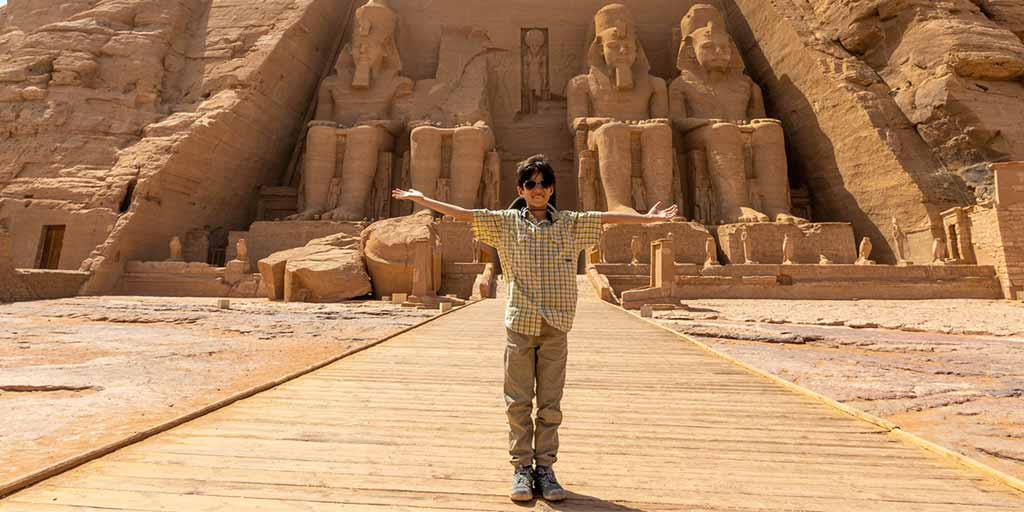
With the exception of the Great Pyramids of Giza, there are few attractions in Egypt that are more identifiable than the massive tributes to Egyptian pharaoh Ramses the II and his wife Nefertari at the temples of Abu Simbel. Enjoying a day trip to Abu Simbel with kids requires navigating a few logistics, but the experience itself is worth the minor challenges of getting here. If you plan on family travel to Abu Simbel read on. I’ll tell you all about the Abu Simbel Temple itself. You’ll learn about how the Abu Simbel Temple was discovered. And we’ll show you how to plan your visit to Abu Simbel with kids.
Our Day Trip To Abu Simbel With Kids
We started our day trip to Abu Simbel with kids with a flight out of Cairo. We woke extra early for the drive to the airport. The streets of Cairo were still flooded by the storm that had forced us to leave the Siwa oasis a day earlier than expected. The Cairo airport was quiet as the world had begun shutting down due to the Covid-19 outbreak that would soon force us to abandon the country. But the cares of the world were forgotten as we passed through Aswan and then on to the small Abu Simbel airport.
We were met there by Ahmed, our guide for the day. And, by guide, I mean, he was responsible for telling us about the temples and bringing us to the temple entrance. There are no guides allowed within the temples themselves. So our interaction with him was pretty brief. Ahmed was arranged by our Traveline Egypt partners who helped us navigate nearly every part of our Egypt travels with the exception of our hot air balloon ride in Luxor. Our guide helped us to get our tickets for both ourselves and our camera and tripod. As with most of the historical sites in Egypt, you are allowed to bring a camera phone into Abu Simbel, but if you want to bring a larger camera or tripod, you will need to pay extra.
At first, the view of Abu Simbel was unimpressive. We walked through the typical security at Egyptian historical sites and along a dirt path over a ridge towards the lake. But as we rounded a corner on the lakeside of the hills, the majesty of the Abu Simbel temples became obvious. The massive, seated, monuments to Ramses II towered above the small entrance to the tomb.
We found some shade near the entrance to the temple, away from the crowds exploring the grounds. Here Ahmed told us the story of the two temples at Abu Simbel.
The Great Temple Of Ramses II
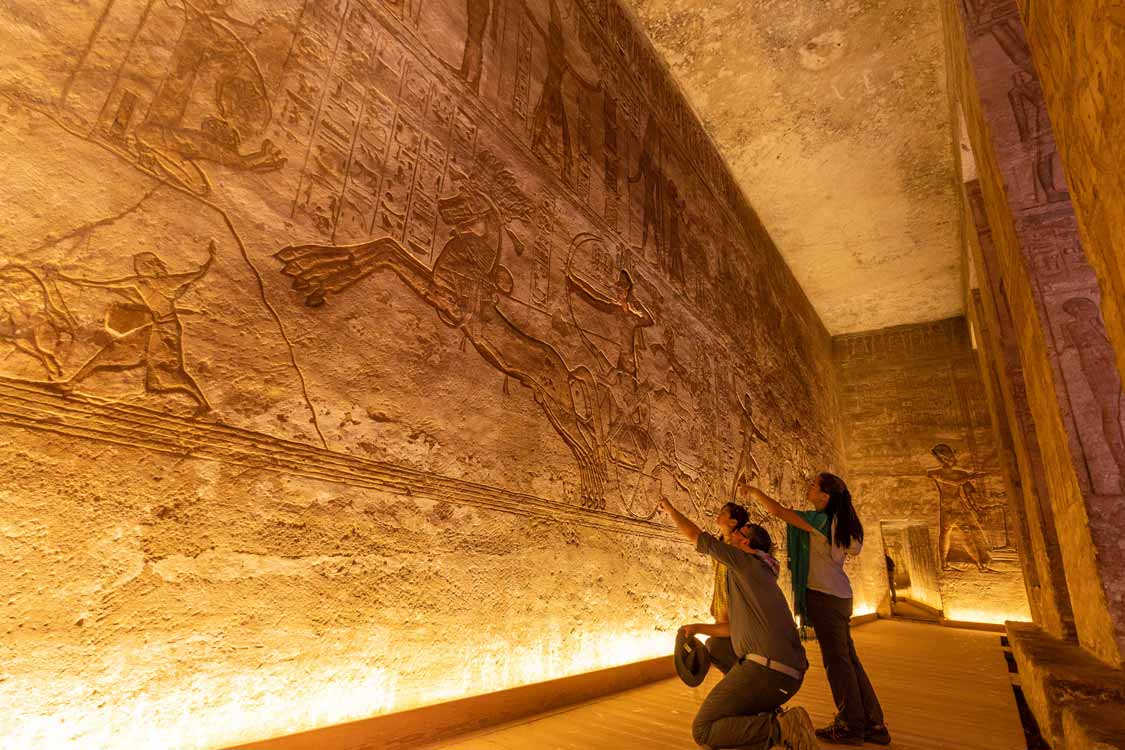
The largest of the two Abu Simbel temples is dedicated to the Egyptian Gods Amun, Ra-Horakhty, and Ptah. But, in reality, this Great Temple is in honor of the deification of Ramesses himself.
The small entrance is flanked by the epic 66 ft. statues of Ramses II sitting on a throne. All of the statues are in excellent shape with the exception of the one on the immediate left of the entrance which was toppled by an earthquake prior to the relocation of the temple complex. Entering the temple was probably the most awe-inspiring experiences during our visit to Egypt. The boys were both dumbfounded by the sheer size of it all.
Even the smaller statues along the legs of those of Ramses II were incredible. They were depictions of Ramses’ wife Nefertari, his mother Mut-Tuy, and his favorite sons Amun-her-kheshef, and Rameses B along with others.
As we entered the chamber we were greeted by the guards, who promptly offered us the chance for C and I to hold the golden Ankh key to the temple in exchange for some tips. This, along with the regular experiences of Egypt such as “Hey, where are you from?” and then calls of “Canada Dry!” were pretty easy to tune out most of the time. I’m 100% sure the key wasn’t real, but it made for a fun way to spend a few Egyptian pounds.
Inside The Great Temple Of Abu Simbel
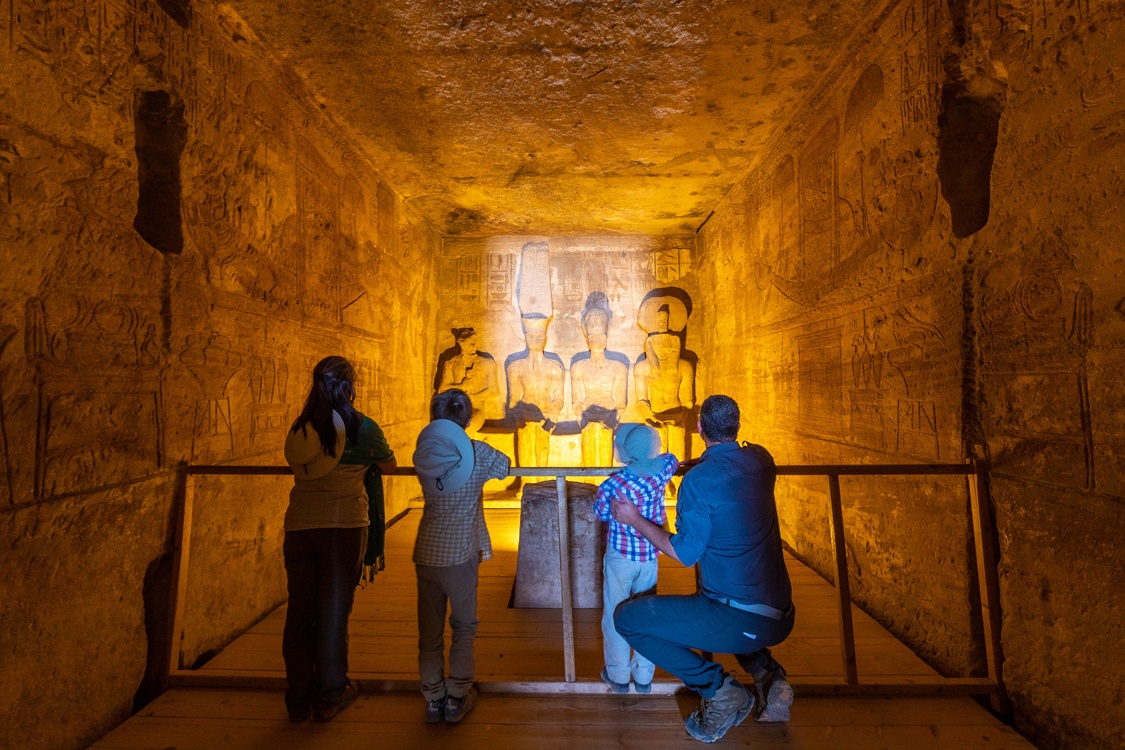
As we stepped into the Great Temple the boys immediately shot off in different directions. D was attracted to the massive depiction of the chariot battle on the left-hand side. The relief depicting the Battle of Kadesh is one of the most fascinating art pieces in the temple. what looks like a many-legged horse is actually one of the earliest depictions of motion in still artwork. The many legs were actually showing the different positions of one horse’s leg during a sequence. As someone who began their career in animation, this was SO fascinating for me.
D, on the other hand ran straight to the back of the temple. It’s here that the four-seated statues of Ra-Horakthy, Rameses II, Amun Ra, and Ptah are located. When the temple sat in its original location, the statues and the lone entrance were aligned so that on October 22 (the birthday of Ramses II) and February 22 (his coronation day) the sun would shine through and illuminate all of the statues except for that of Ptah, who was considered a God of the underworld.
We could easily have spent far more time exploring the Great Ramses II than the 45-minutes that we gave it. We only had about an hour and a half to explore Abu Simbel with kids so we wanted to set some time aside for the temple of Nefertari.
The Small Temple of Nefertari
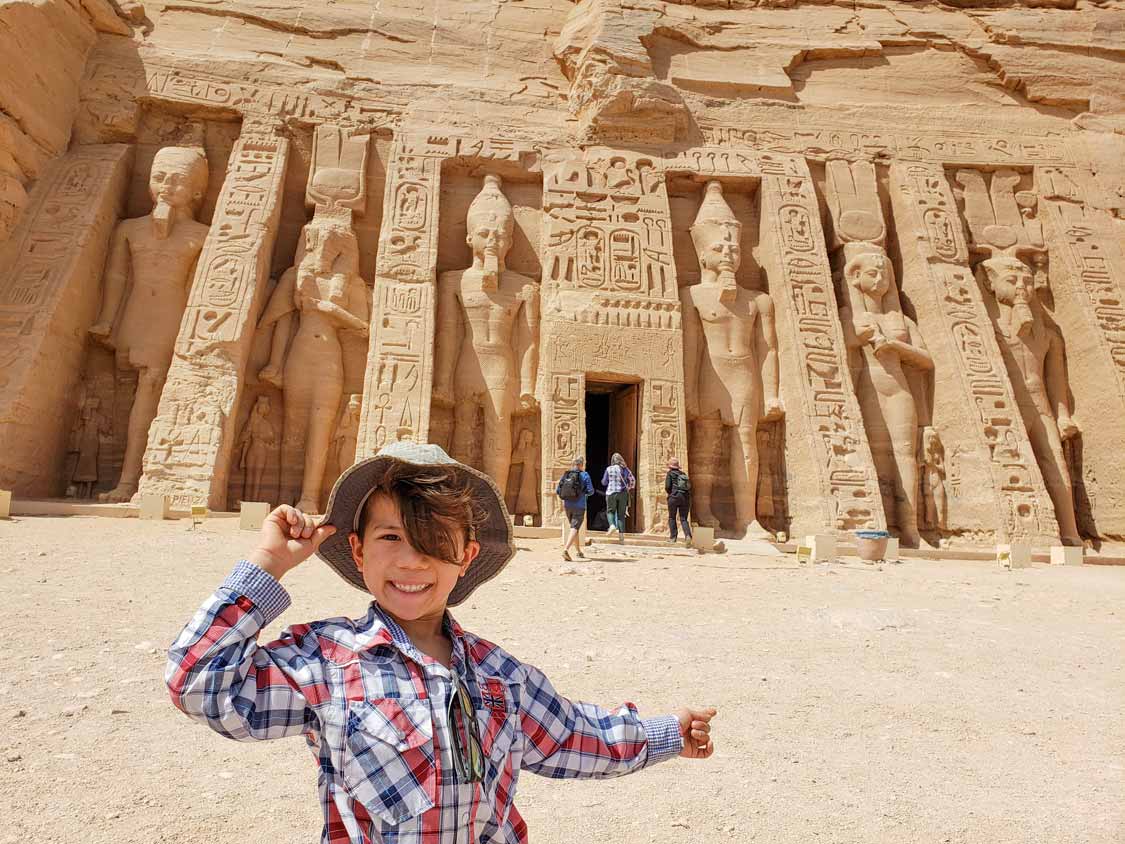
The small temple of Abu Simbel is dedicated to the favorite wife of Ramses II, Nefertari. As we explored it, Christina didn’t seem to find my comments about her being my ‘favorite’ wife to be very funny.
The 33 ft tall statues of Ramses II and his wife weren’t as epic as those of the Great Temple. But, in any other situation they would have been mind-blowing. A unique thing about the statues of Nefertari Temple is that they depict both Ramses II and Nefertari in equal sizes. Most other royal depictions always show the king as far larger than the queen.
Inside The Small Temple Of Abu Simbel
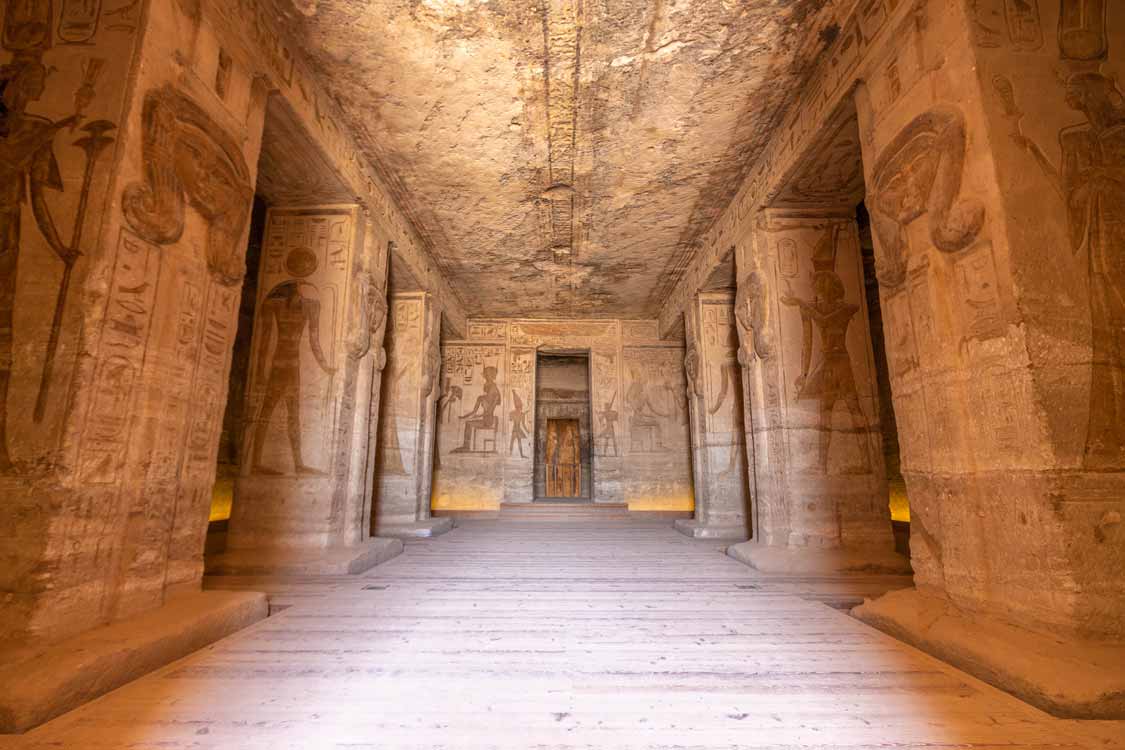
As we entered the small temple of Nefertari in Abu Simbel with kids the boys were immediately drawn to the intricately decorated pillars. The pillars showed queen Nefertari playing music with a number of the Egyptian Gods. Further into the temple were three rooms, each showing a different scene of the King and his wife making offerings to various gods.
The temple wasn’t as intricate as the temple of Ramses II, but it was still incredible to explore. Before long the 20-minutes that we had set aside to explore the temple had vanished. We had spent most of our time trying to decipher the thousands of hieroglyphs that adorned the walls.
Our Abu Simbu Video
We made sure to put together some awesome footage of our visit to Abu Simbel with kids. You can check that out below. Make sure like and subscribe so you see more of our family adventure travel videos.
What Are The Abu Simbel Temples?
The Abu Simbel temples are a set of two massive stone temples in the Aswan region. These two, spectacular structures, one dedicated (by himself) to Egyptian Pharaoh Ramses II, and one to his wife Nefertari. The two temples were carved into the mountains during the 13th century BC under the orders of King Ramses II. They served a dual-purpose of celebrating his victory at the battle of Kadesh and signifying his position as a deity.
Ramses II had two unique temples built. One, featuring four reliefs of himself seated on the outside, is one of the most iconic temples in all of Egypt. The other featuring a tribute to his favorite wife and smaller tributes to his children.
Not only are the Abu Simbel temples considered some of the most incredible places in all of Egypt, but their modern history is just as fascinating. Especially for those exploring Egypt with children. The first was the western discovery of the Abu Simbel temples in 1813 when a young boy, named Abu Simbel, helped guide Swiss explorer Jean-Louis Burckhardt to the site. It reminded my kids a lot of the story of the young boy leading explorer Hiram Bingham to Machu Picchu in Peru.
Relocation Of The Abu Simbel Temples
Nearly as impressive as the Abu Simbel temples themselves is the story of how they were saved from destruction when the High Dam in Aswan was planned. To save the temples from the water there were several plans made. One included the idea of “underwater” viewing chambers that would allow visitors to explore the submerged ruins. That would have made for one heck of a different experience.
But the winning bid involved the massive $40 million mission to move the temples. They and their associated mountains were moved block by block to higher ground out of the flood plain. From 1964 to 1968 a team of archaeologists and heavy equipment operators carefully sliced the entire site into blocks ranging from 10 to 30 tons. The blocks were reassembled 215 feet higher up. The undertaking was considered one of the most incredible feats of archaeological engineering in history.
Tips For Your Day Trip To Abu Simbel With Kids
Enjoying your day trip to Abu Simbel with kids requires some planning in advance. I’ve laid out everything I learned from our visit to the temples to help you out.
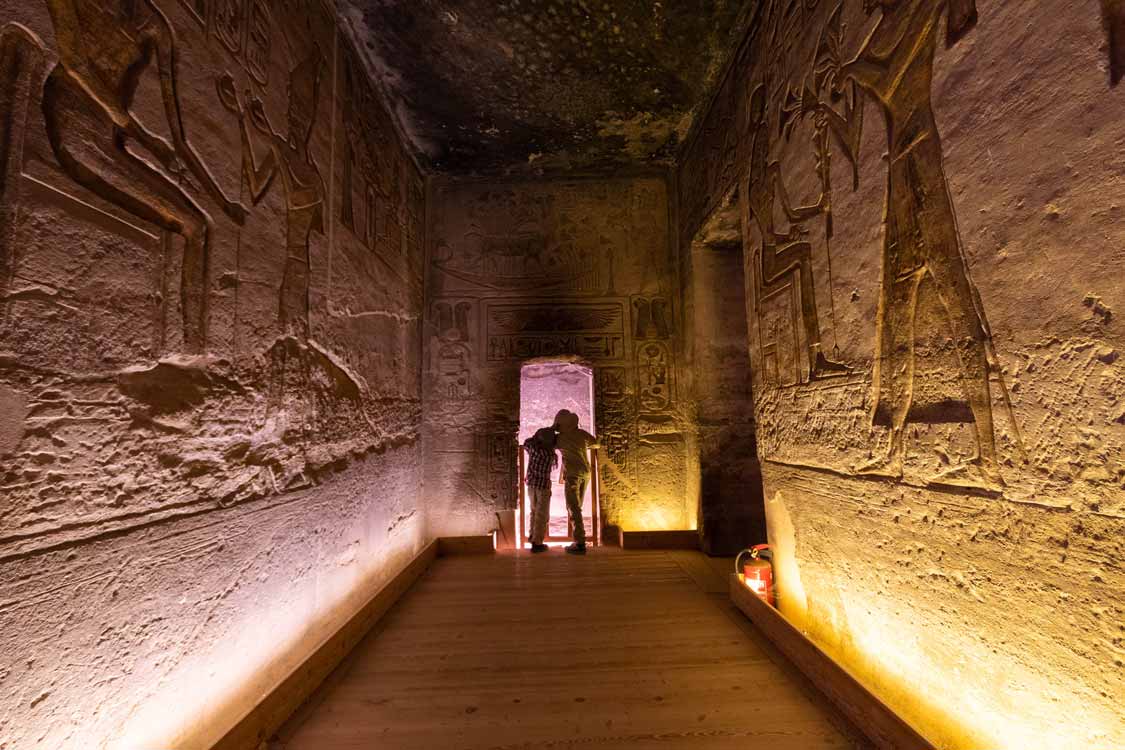
Where Are The Abu Simbel Temples?
The Abu Simbel Temples are located in the Aswan region of Upper Egypt not far from the Sudan border. The impressive ruins sit on a plateau overlooking Lake Nassar. It’s often visited as a day trip from both Aswan and Cairo. The town of Abu Simbel itself is rarely included in an Abu Simbel itinerary. But this small town, which has an airport and a few hotels and restaurants can be a nice place to spend the night if you’re looking to do a multi-day trip to Abu Simbel Egypt.
Getting To Abu Simbel With Kids
The Abu Simbel temples are visited by just a few hundred tourists per day. And it’s rare to see visitors exploring Abu Simbel with kids. Most visitors arrived by bus convoy from Aswan. The route takes about three and a half hours.
Others, like us, take advantage of the small Abu Simbel airport. This makes it possible to make a visit to Abu Simbel part of a day trip from Cairo as well. The flights from Cairo always stop in Aswan on both the way to Abu Simbel and the return trip to Cairo. Those who arrive by plane will catch either a guided bus tour at the airport, or take advantage of the numerous taxi’s to get from the Abu Simbel airport to the Abu Simbel temples.
Whether you take the bus to Abu Simbel or fly to the town, your day trip to Abu Simbel will be pretty regimented. Each option gives about two and a half to three hours of time on the ground. If you fly from Cairo or Aswan to Abu Simbel you’ll have a little less time as you’ll also need to account for the transportation time and the fact that you’ll need to get back to the airport and go through security.
Another option of how to get to Abu Simbel is via a Lake Nassar and Nile cruise. This option is definitely not a day trip to Abu Simbel. It takes several days to do the cruise. But you’ll stop at various historic temples and towns. Many of these can only be reached by boat. This cruise explores many of the sites including Abu Simbel.
Is Abu Simbu Stroller Friendly?
If you have a rugged stroller you may be able to use it from the parking lot to the temples. The ground is rocky, but the path is well-trodden.
Are There Bathrooms At Abu Simbel?
There are bathrooms located near the Abu Simbel parking lot. As usual, you’ll be expected to pay a small amount (1-2 EGP) for access. Although if you don’t small bills, you usually won’t be harassed.
Is there Food Available At The Abu Simbel Temples?
There are shops located near the entrance to the Abu Simbel temples. We didn’t take advantage of them. We had a boxed lunch waiting for us for the return trip and we didn’t want to lose any time that we had available to explore the ruins. For those spending more time in Abu Simbel, most shops have drinks and snacks available. The Eskaleh Eco Lodge is a full restaurant and hotel with a number of options for those looking for a complete meal.
Disclosure: We partnered with Traveline Egypt to make the most of our travels in Egypt. All opinions remain our own. Wandering Wagars is a participant in the Amazon Services LLC Associates Program, an affiliate advertising program designed to provide a means for sites to earn advertising fees by advertising and linking to amazon.com, amazon.co.uk, amazon.ca. Amazon and the Amazon logo are trademarks of Amazon.com, Inc. or its affiliates.
You May Also Like To Read:
Pin This For Later:
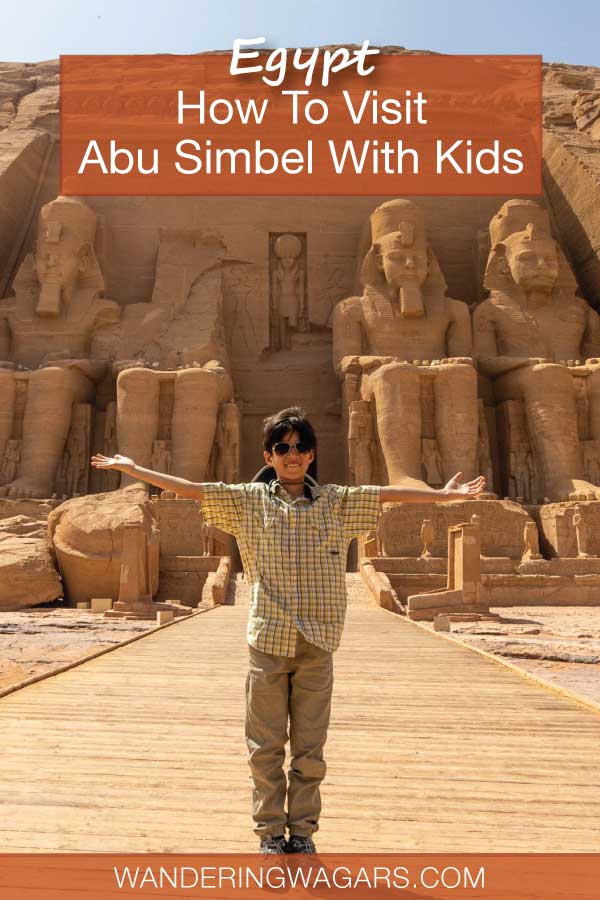


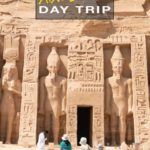

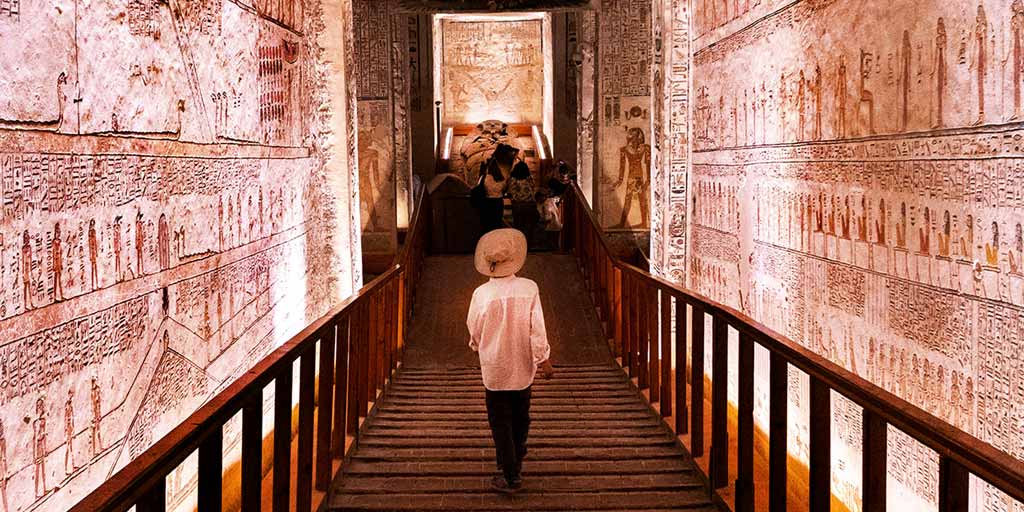
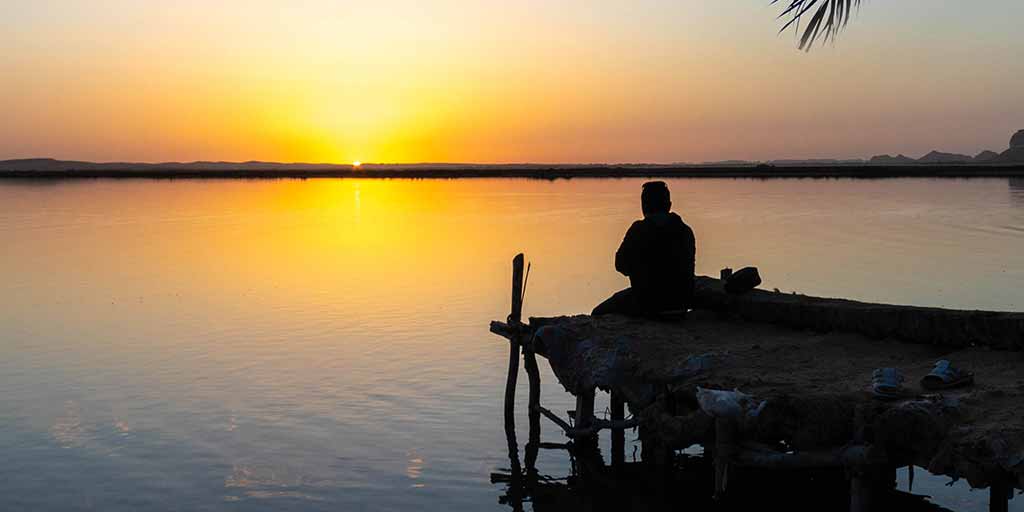
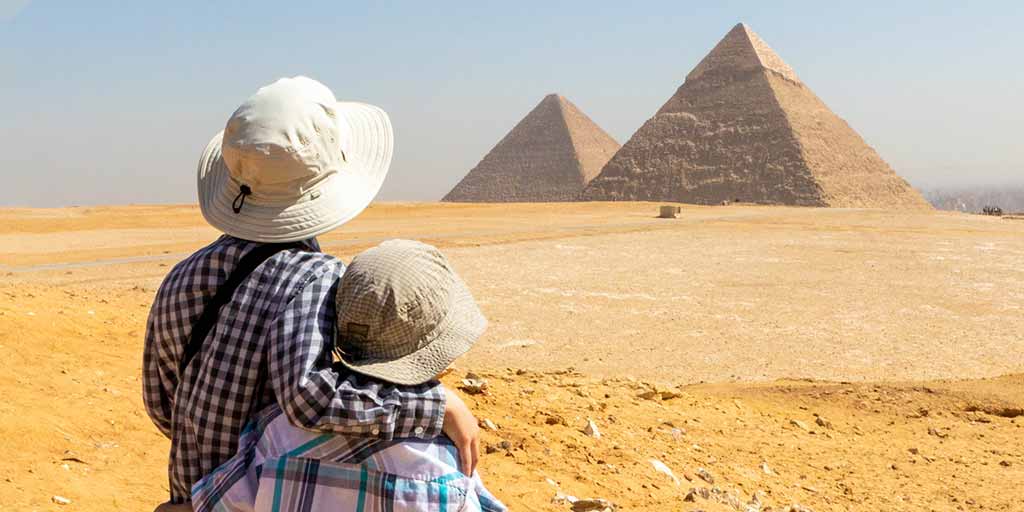

Cosette
Monday 25th of May 2020
Egypt is high on my bucket list. Looks incredible. Great your sons got see it.
Kevin Wagar
Friday 29th of May 2020
I hope you get a chance to visit Egypt soon Cosette!
Ryan K Biddulph
Monday 18th of May 2020
Looks like a blast as always guys. Definitely on my travel list for a long time, Egypt is. Thanks for sharing the helpful review here. Fabulous featured image too.